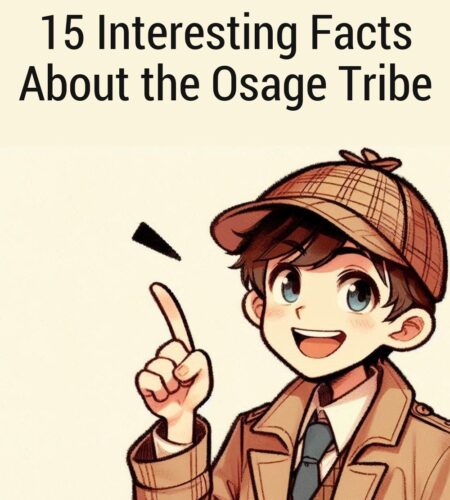The Osage Tribe, also known as the Osage Nation, is a Native American tribe with a rich and storied history. Originating in the Ohio Valley, the Osage people eventually settled in present-day Missouri, Arkansas, and Oklahoma. In this article, we’ll explore 15 intriguing facts about the Osage Tribe, shedding light on their culture, traditions, and resilience throughout history.
Fact 1: Original Homeland
The Osage Tribe’s journey began in the Ohio Valley, where they were one of many Siouan-speaking tribes. They later migrated westward, eventually settling in the Mississippi Valley and, eventually, the Ozark Plateau.
- Ohio Valley Roots: The Osage Tribe’s ancestral lands were in the Ohio Valley, where they lived as a hunting and gathering society.
- Westward Migration: Due to pressure from European settlers and other tribes, the Osage people embarked on a westward journey, seeking new homelands.
- Settling in the Ozarks: The Osage Tribe finally found their place in the Ozark Plateau, which includes parts of present-day Missouri, Arkansas, and Oklahoma.
Fact 2: Osage Language
The Osage Tribe has a unique language, which is part of the Dhegiha branch of the Siouan language family.
- Intricate Phonetics: The Osage language is known for its complex phonetic features, including the use of voiceless and voiced sounds.
- Efforts to Preserve: Today, there are ongoing efforts to preserve and revitalize the Osage language, ensuring that it continues to thrive.
- Cultural Significance: The language is integral to the Osage Tribe’s cultural identity and heritage.
Fact 3: Osage Clans
The Osage Tribe is organized into matrilineal clans, with each clan holding its own distinct role and responsibilities within the tribe.
- Eldest Daughter Leadership: In Osage society, leadership is often passed down through the eldest daughter of a clan, making it a matriarchal culture.
- Diverse Roles: Each clan has specific roles, such as those related to governance, ceremonies, or medicinal knowledge.
- Clan Unity: The clans play a vital role in maintaining unity and balance within the tribe.
Fact 4: Bison Hunt
Bison hunting was a central aspect of the Osage way of life, providing sustenance, clothing, and cultural significance.
- Hunting Parties: Osage men organized hunting parties to track and hunt bison, utilizing their meat, hides, and bones for various purposes.
- Nomadic Lifestyle: The Osage people followed the bison herds across the Great Plains, adopting a semi-nomadic lifestyle.
- Spiritual Connection: Bison were not just a source of material wealth but also held spiritual significance in Osage culture.
Fact 5: White Hair
White Hair, or Pawhuska, was a prominent Osage leader who played a crucial role in the tribe’s history.
- Tribal Diplomat: White Hair served as a diplomat and negotiator for the Osage Tribe, helping to establish peaceful relations with the United States.
- Legacy of Peace: His efforts in diplomacy contributed to the tribe’s preservation and peaceful coexistence with European settlers.
- City Named in His Honor: The city of Pawhuska, Oklahoma, is named after White Hair, commemorating his contributions.
Fact 6: Resilience During Relocation
Like many Native American tribes, the Osage people faced forced relocations, but they persevered.
- Land Loss: The Osage Tribe’s territory was continually reduced due to treaties and land cessions, leading to several relocations.
- Adaptation: Despite these challenges, the Osage people adapted to new environments and preserved their cultural heritage.
- Reservation Life: The tribe eventually settled in Osage County, Oklahoma, where they established their reservation, which remains their home today.
Fact 7: Osage Women and Ribbonwork
Osage women are renowned for their skill in ribbonwork, an intricate and colorful form of textile art.
- Elaborate Designs: Ribbonwork involves the sewing of vibrant ribbons into intricate geometric patterns on clothing and regalia.
- Ceremonial Importance: Ribbonwork is often incorporated into traditional Osage clothing for special occasions and ceremonies.
- Generational Art: The art of ribbonwork is passed down through generations, keeping the tradition alive.
Fact 8: Osage War Societies
The Osage Tribe had several war societies, each with its distinct role and responsibilities.
- Guardians of the Tribe: War societies were responsible for protecting the Osage people and their lands from external threats.
- Cultural Significance: These societies played a crucial role in maintaining the tribe’s cultural traditions and defending their territory.
- Continuation of Traditions: Today, war societies continue to participate in cultural events, ensuring that their legacy persists.
Fact 9: Osage Casinos
In modern times, the Osage Tribe has successfully operated casinos, contributing to their economic self-sufficiency.
- Economic Empowerment: The establishment of casinos has been a source of economic stability and self-sufficiency for the Osage people.
- Education and Healthcare: Casino revenues have supported education and healthcare initiatives, benefiting not only the tribe but also surrounding communities.
- Preservation of Culture: The financial success of these enterprises has allowed the Osage Tribe to invest in the preservation of their cultural heritage.
Fact 10: Osage Nation Museum
The Osage Nation Museum, located in Pawhuska, Oklahoma, is dedicated to preserving and celebrating Osage culture.
- Cultural Artifacts: The museum houses a vast collection of cultural artifacts, art, photographs, and documents that tell the story of the Osage Tribe.
- Educational Center: It serves as an educational resource for both Osage and non-Osage visitors, promoting an understanding of the tribe’s history and traditions.
- Community Engagement: The museum actively engages with the Osage community and encourages the continued expression of their cultural heritage.
Fact 11: Osage Dance and Music
Dance and music are integral to Osage culture, playing a crucial role in their ceremonies and celebrations.
- Drumming and Singing: The Osage people incorporate drumming and singing into various ceremonies, including dances like the Inlonschka, or “Five Moons,” dance.
- Regalia and Headdresses: Dancers wear intricate regalia, adorned with ribbons, beadwork, and headdresses, symbolizing their connection to nature and the spirits.
- Continuing Traditions: The Osage Tribe continues to pass down traditional dances and songs, ensuring that these cultural expressions endure.
Fact 12: Ribbon Work and Clothing
Ribbon work is a significant aspect of Osage traditional clothing, symbolizing their cultural identity and heritage.
- Elaborate Patterns: Osage clothing often features intricate ribbonwork designs, which vary in color and pattern, representing different clans and families.
- Ceremonial Garb: Ribbonwork is a prominent feature in ceremonial clothing, worn during special occasions and events
- Spiritual Significance: The ribbonwork on Osage clothing is imbued with spiritual significance, connecting wearers to their ancestors and the natural world.
Fact 13: Osage Tribal Council
The Osage Tribal Council serves as the governing body of the Osage Nation, responsible for making decisions on behalf of the tribe.
- Sovereign Nation: The Osage Nation operates as a sovereign entity, with the authority to make decisions regarding tribal matters and governance.
- Economic and Cultural Decisions: The council plays a vital role in managing economic enterprises, preserving cultural heritage, and addressing the needs of the Osage people.
- Democratic Representation: The council members are elected by the Osage people, ensuring a democratic process for tribal governance.
Fact 14: Osage Murders Investigation
The Osage Tribe faced a dark chapter in their history with a series of murders in the 1920s.
- Reign of Terror: A series of murders, often referred to as the “Osage Indian Murder Investigation,” saw Osage tribe members targeted for their oil wealth, leading to a reign of terror.
- Benevolent Agents: The investigation into the murders, led by the Osage and the FBI, sought to bring justice and protect the rights of the tribe.
- Legacies and Healing: The Osage people and the nation as a whole have worked to heal the wounds of this painful period, seeking justice and remembrance for the victims.
Fact 15: Contemporary Osage Culture
The Osage Tribe continues to thrive and preserve their culture in the modern world.
- Cultural Centers: The tribe operates cultural centers and institutions that celebrate their heritage and educate both tribal and non-tribal members.
- Educational Initiatives: Osage youth have access to cultural education and language programs, ensuring that traditions are passed down to future generations.
- Diverse Celebrations: The Osage Tribe continues to participate in cultural celebrations, ensuring the perpetuation of their rich history and traditions.
Conclusion
The Osage Tribe’s history is a tapestry of resilience, culture, and enduring traditions. From their ancient roots in the Ohio Valley to their contemporary preservation of language, arts, and governance, the Osage people have faced challenges and embraced their heritage. The Osage Tribe remains a vibrant and vital part of Native American culture, fostering an understanding of their past while building a promising future for generations to come.
Subscribe to our email newsletter to get the latest posts delivered right to your email.





Comments